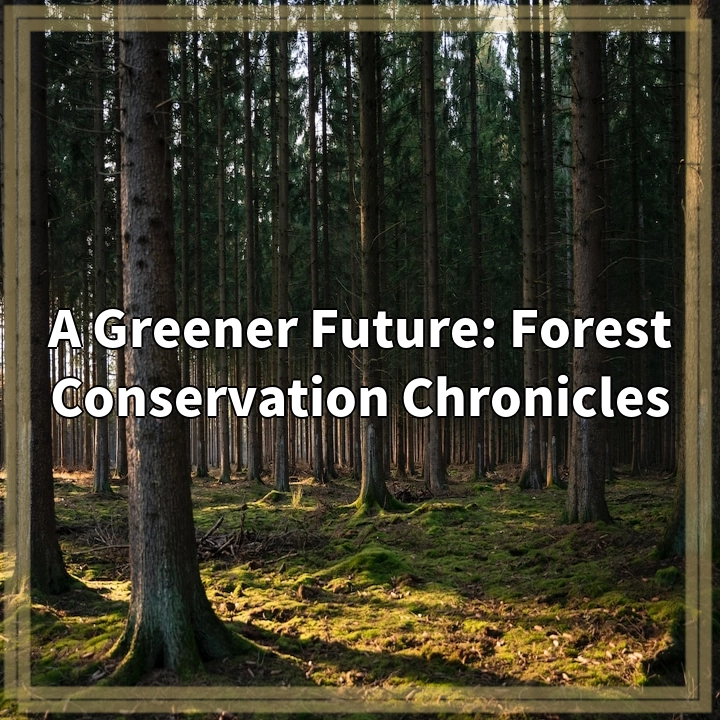
What it is:
A Greener Future: Forest Conservation Chronicles is a comprehensive initiative aimed at promoting the conservation and restoration of forest ecosystems. This initiative recognizes the critical role that forests play in maintaining biodiversity, mitigating climate change, and providing various ecosystem services. Through this initiative, various strategies and actions are implemented to address the ongoing threats faced by forests worldwide and to work towards creating a more sustainable and resilient future for our planet.
Real-world problems:
Forests around the world are facing numerous challenges and threats that are diminishing their health and resilience. These problems include:
Deforestation:
Deforestation, driven primarily by agricultural expansion, logging, and infrastructure development, poses one of the most significant threats to forests globally. The loss of forests leads to habitat destruction, loss of biodiversity, and releases large amounts of carbon dioxide into the atmosphere, contributing to climate change.
Illegal logging:
Illegal logging activities continue to compromise forest ecosystems and their biodiversity. Unregulated timber extraction not only depletes valuable forest resources but also undermines local economies and contributes to social unrest. In addition, illegal logging often involves corruption, money laundering, and human rights violations.
Climate change impacts:
Forests are vulnerable to the impacts of climate change, including rising temperatures, altered rainfall patterns, and increased frequency and intensity of extreme weather events. These changes can lead to increased forest fires, insect outbreaks, disease spread, and overall decreased forest productivity and health.
Land-use change:
Ongoing conversion of forests to agricultural land, plantations, urban areas, and infrastructure development negatively affects the integrity and functionality of forest ecosystems. Fragmentation of forests and loss of connectivity reduce habitat quality and restrict the movement of wildlife, leading to population declines and even species extinction.
Poaching and illegal wildlife trade:
Forests are home to diverse plant and animal species, some of which are highly sought after in illegal wildlife trade. Poaching, driven by demand for products such as ivory, rhino horns, and exotic pets, poses a significant threat to many iconic and endangered species, further disrupting delicate forest ecosystems.
Addressing these real-world problems is essential for the conservation and restoration of forests. By implementing effective management practices, raising awareness, and engaging local communities and policymakers, A Greener Future: Forest Conservation Chronicles aims to mitigate these threats and work towards a sustainable future where forests thrive and benefit both nature and society.

Solutions:
The challenges facing forests require a multi-faceted approach that combines various solutions. Here are some strategies to address the real-world problems associated with forest conservation:
Raising awareness and education:
Educating the public about the importance of forests and the threats they face is essential. This can be achieved through campaigns, workshops, and educational programs that highlight the ecological, economic, and societal benefits of forests, as well as the consequences of their destruction.
Supporting sustainable forestry practices:
Encouraging sustainable management practices such as selective logging, reforestation, and agroforestry can help maintain the integrity of forests. This involves promoting certification programs, responsible sourcing, and supporting communities engaged in sustainable forest-based livelihoods.
Strengthening law enforcement and governance:
Addressing illegal logging and wildlife trade requires strong law enforcement, improved governance, and international cooperation. Implementing more robust regulations, monitoring systems, and penalties for illegal activities can act as effective deterrents and combat these illicit practices.
Conservation of protected areas:
Expanding and effectively managing protected areas can safeguard critical forest ecosystems and halt encroachment and destructive activities. Efforts to establish and maintain protected areas contribute to preserving biodiversity, providing habitat for wildlife, and maintaining ecosystem services.
Promoting sustainable land-use planning:
Implementing land-use planning that prioritizes sustainable practices and considers the ecological value of forests is crucial. This involves avoiding deforestation for agriculture and infrastructure projects, promoting reforestation in degraded areas, and ensuring effective spatial planning that balances conservation needs with development goals.
Engaging local communities and stakeholders:
Collaborating with local communities, indigenous groups, and other stakeholders is vital. Involving them in decision-making processes, recognizing their traditional knowledge, and supporting sustainable livelihoods can foster a sense of ownership and ensure long-term conservation efforts.
By implementing these solutions, we can actively contribute to the conservation and restoration of forests, protecting their invaluable biodiversity and preserving the many benefits they provide for the planet and future generations.















